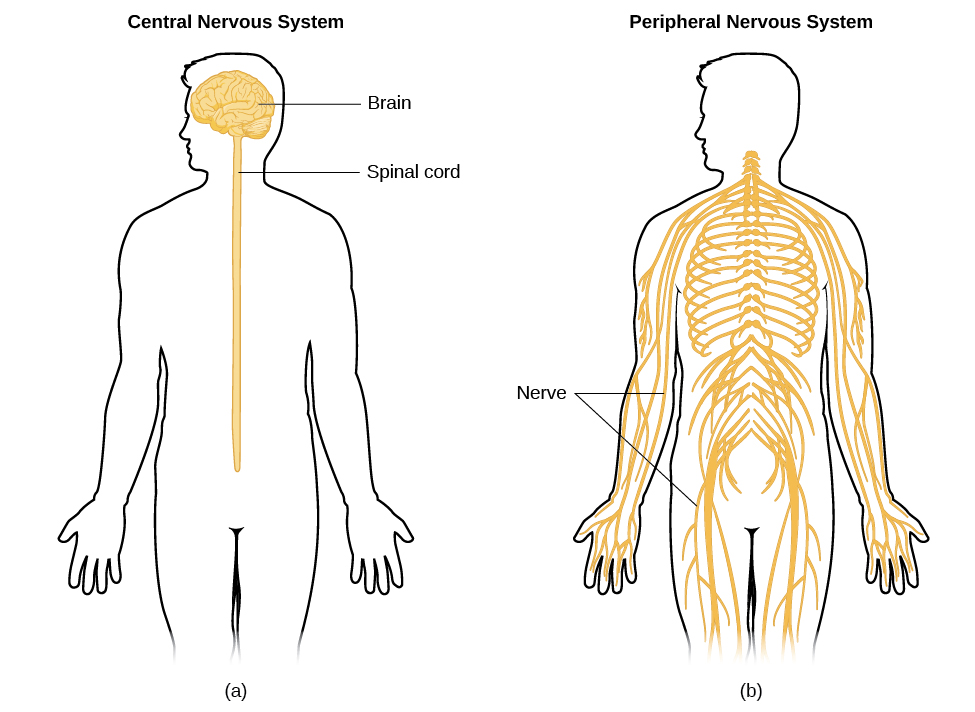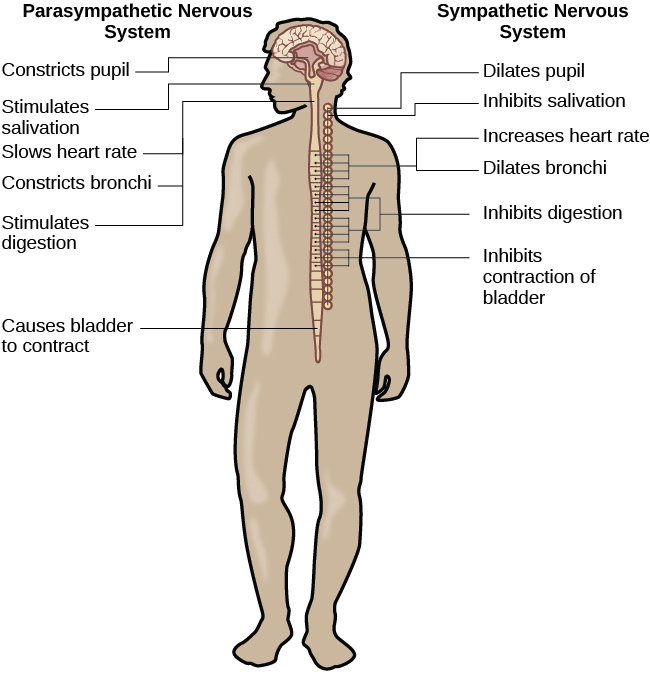Chapter 4. Biological Basis of Behaviour
Parts of the Nervous System
Tareq Yousef
Approximate reading time: 7 minutes
Learning Objectives
By the end of this section, you will be able to:
- Consider the difference between the central and peripheral nervous systems
- Express the difference between the somatic and autonomic nervous systems
- Acknowledge differences between the sympathetic and parasympathetic divisions of the autonomic nervous system
The nervous system can be divided into two major subdivisions: the central nervous system (CNS) and the peripheral nervous system (PNS), shown in Figure BB.7. The CNS comprises the brain and spinal cord; the PNS connects the CNS to the rest of the body. In this section, we focus on the peripheral nervous system; later, we look at the brain and spinal cord.

Peripheral Nervous System
The peripheral nervous system is made up of thick bundles of axons, called nerves, carrying messages back and forth between the CNS and the muscles, organs, and senses in the periphery of the body (i.e., everything outside the CNS). The PNS has two major subdivisions: the somatic nervous system and the autonomic nervous system.
The somatic nervous system is associated with activities thought of as conscious or voluntary. It is involved in the relay of sensory and motor information to and from the CNS; therefore, it consists of motor neurons and sensory neurons. Motor neurons, carrying instructions from the CNS to the muscles, are efferent fibres (efferent means “moving away from”). Sensory neurons, carrying sensory information to the CNS, are afferent fibres (afferent means “moving toward”). A helpful way to remember this is that efferent = exit and afferent = arrive. Each nerve is basically a bundle of neurons forming a two-way superhighway, containing thousands of axons, both efferent and afferent.
There is another type of neuron, called an interneuron, which is by far the most common type of neuron, located primarily within the CNS responsible for communicating among the neurons. Interneurons allow the brain to combine the multiple sources of available information to create a coherent picture of the sensory information being conveyed.
The autonomic nervous system controls our internal organs and glands and is generally considered to be outside of our voluntary control. It can be further subdivided into the sympathetic and parasympathetic divisions (Figure [below]).
The Divisions of the Autonomic Nervous System
The sympathetic nervous system is involved in preparing the body for stress-related activities; the parasympathetic nervous system is associated with returning the body to routine, day-to-day operations. The two systems have complementary functions, operating in tandem to maintain the body’s homeostasis. Homeostasis is a state of equilibrium, or balance, in which biological conditions (such as body temperature) are maintained at optimal levels.

The sympathetic nervous system is activated when we are faced with stressful or high-arousal situations. The activity of this system was adaptive for our ancestors, increasing their chances of survival. Imagine, for example, that one of our early ancestors suddenly disturbs a large bear with cubs. At that moment, our ancestor’s body undergoes a series of changes — a direct function of sympathetic activation — preparing the hunter to face the threat. The hunter’s pupils dilate (expand), their heart rate and blood pressure increase, their bladder relaxes (to reduce the chance of needing a bathroom break!), their liver releases glucose (a sugar readily used by the body for energy), and adrenaline surges into the hunter’s bloodstream. This constellation of physiological changes, known as the fight or flight response, allows the body access to energy reserves and heightened sensory capacity so that it might fight off a threat or run away to safety.
While it is clear that such a response would be critical for survival for our ancestors, who lived in a world full of real physical threats, many of the high-arousal situations we face in the modern world are more psychological in nature. For example, think about how you feel when you have to stand up and give a presentation in front of a roomful of people, or right before taking a big test. You are in no real physical danger in those situations, and yet you have evolved to respond to a perceived threat with the fight or flight response.
This kind of response is not nearly as adaptive in the modern world; in fact, we suffer negative health consequences when faced constantly with psychological threats that we can neither fight nor flee. Recent research suggests that an increase in susceptibility to heart disease (Chandola, Brunner, & Marmot, 2006) and impaired function of the immune system (Glaser & Kiecolt- Glaser, 2005) are among the many negative consequences of persistent and repeated exposure to stressful situations. Some of this tendency for stress reactivity can be wired by early experiences of trauma.
After the threat has been resolved, the parasympathetic nervous system takes charge and restores bodily functions to a relaxed state. Our ancestor’s heart rate and blood pressure return to normal, their pupils constrict (become small), they regain control of their bladder, and the liver starts storing glucose as glycogen (a modified form of glucose that is easier to store) for future use. These restorative processes happen due to the activation of the parasympathetic nervous system.
Image Attributions
Figure BB.7. Figure 3.13 as found in Psychology 2e by OpenStax is licensed under a CC BY 4.0 License.
Figure BB.8. Figure 3.14 as found in Psychology 2e by OpenStax is licensed under a CC BY 4.0 License.
To calculate this time, we used a reading speed of 150 words per minute and then added extra time to account for images and videos. This is just to give you a rough idea of the length of the chapter section. How long it will take you to engage with this chapter will vary greatly depending on all sorts of things (the complexity of the content, your ability to focus, etc).
brain and spinal cord
connects the brain and spinal cord to the muscles, organs and senses in the periphery of the body
relays sensory and motor information to and from the CNS
controls our internal organs and glands
involved in stress-related activities and functions
associated with routine, day-to-day operations of the body
state of equilibrium — biological conditions, such as body temperature, are maintained at optimal levels
activation of the sympathetic division of the autonomic nervous system, allowing access to energy reserves and heightened sensory capacity so that we might fight off a given threat or run away to safety

